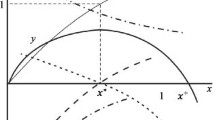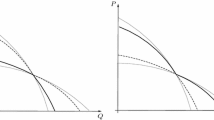Abstract
This paper deals with the equilibria of games when the agents have multiple objectives and, therefore, their utilities cannot be represented by a single value, but by a vector containing the various dimensions of the utility. Our approach allows the incorporation of partial information about the preferences of the agents into the model, and permits the identification of the set of equilibria in accordance with this information. We also propose an additional conservative criterion which can be applied in this framework in order to predict the results of interaction. The potential application of the theoretical results is shown with an analysis of a mixed oligopoly in which the agents value additional objectives other than their own benefit. These objectives are related to social welfare and to the profit of the industry. The flexibility of our approach provides a general theoretical framework for the analysis of a wide range of strategic economic models.




Similar content being viewed by others
Notes
For instance, a sufficient condition for the two sets to coincide is that the sets \(A^i\) are non-empty convex subsets of a finite dimensional space, and the functions \(u_j^i\) are strictly concave in \(a^i\).
Other representations of this objective exist. However, this form is convenient for our analysis.
References
Aumann, R. (1962). Utility theory without the completeness axiom. Econometrica, 30, 445–462.
Bade, S. (2005). Nash equilibrium in games with incomplete preferences. Economic Theory, 26, 309–332.
Bewley, T. (1986). Knightian utility theory: Part 1. Cowles Foundation Discussion Paper 807.
Blackwell, D. (1956). An analog of the minimax theorem for vector payoffs. Pacific Journal of Mathematics, 6, 1–8.
Borm, P. E. M., Tijs, S. H., & Van Den Aarssen, J. C. M. (1988). Pareto equilibria in multiobjective games. Methods of Operations Research, 60, 303–312.
Corley, H. W. (1985). Games with vector payoffs. Journal of Optimization Theory and Applications, 47, 491–498.
De Fraja, G., & Del Bono, F. (1989). Alternative strategies of a public enterprise in oligopoly. Oxford Economic Papers, 41, 302–331.
De Fraja, G., & Del Bono, F. (1990). Game theoretic models of mixed oligopoly. Journal of Economic Surveys, 4, 1–7.
Dubra, J., Maccheroni, F., & Ok, E. (2004). Expected utility theory without the completeness axiom. Journal of Economic Theory, 115, 118–133.
Gilboa, I., & Schmeidler, D. (1989). Maxmin expected utility with non-unique prior. Journal of Mathematical Economics, 18, 141–153.
Keeney, R. L., & Raiffa, H. (1976). Decisions with multiple objectives: Preferences and value tradeoffs. New York: Wiley.
Kozhan, R., & Salmon, M. (2009). Uncertainty aversion in a heterogeneous agent model of foreign exchange rate formation. Journal of Economic Dynamics & Control, 33, 1106–1122.
Kreps, D. M., & Scheinkman, J. A. (1983). Quantity precommitment and Bertrand competition yield Cournot outcomes. The Bell Journal of Economics, 14, 326–337.
Merrill, W., & Schneider, N. (1966). Government firms in oligopoly industries: A short run analysis. Quarterly Journal of Economics, 80, 400–12.
Nash, J. (1951). Non-cooperative games. Annals of Mathematics, 54(2), 286–295.
Ok, E. A. (2002). Utility representation of an incomplete preference relation. Journal of Economic Theory, 104, 429–449.
Park, J. (2015). Potential games with incomplete preferences. Journal of Mathematical Economics, 61, 58–66.
Patriche, M. (2014). Existence of equilibrium for multiobjective games in abstract convex spaces. Mathematical Reports, 16, 243–252.
Sagi, J. S. (2006). Anchored preference relations. Journal of Economic Theory, 13(1), 283–295.
Shafer, W., & Sonnenschein, H. (1975). Equilibrium in abstract economies without ordered preferences. Journal of Mathematical Economics, 2, 345–348.
Shapley, L. S. (1959). Equilibrium points in games with vector payoffs. Naval Research Logistics Quarterly, 6(1), 57–61.
Voorneveld, M., Vermeulen, D., & Borm, P. (1999). Axiomatizations of Pareto equilibria in multicriteria games. Games and Economic Behavior, 28, 146–154.
Wakker, P. (2001). Testing and characterizing properties of nonadditive measures through violations of the sure-thing principle. Econometrica, 69(4), 1039–1059.
Wald, A. (1950). Statistical decision functions. New York: Wiley.
Wang, S. Y. (1993). Existence of Pareto equilibrium. Journal of Optimization Theory and Applications, 79, 373–384.
Zeleny, M. (1975). Games with multiple payoff. International Journal of Game Theory, 4(4), 179–191.
Zhao, J. (1991). The equilibria of multiple objective games. The International Journal of Game Theory, 20, 171–182.
Acknowledgements
The research of the authors is partially supported by the Spanish Ministry of Economy and Competitiveness, Project ECO2015-68856-P (MINECO/FEDER) .
Author information
Authors and Affiliations
Corresponding author
Appendix
Appendix
Proof of Theorem 2.3
First, note that under the assumptions, all the values \(r_j^i(a^{-i})\) are well-defined. Let \(a\in \times _{i\in N}A^i\) be a profile of strategies such that for a certain \(i\in N, a^i< {\underline{r}}^i(a^{-i})\). Since \(u_j^i\) is strictly concave in its own action, then at \(a^i, u_j^i\) is strictly increasing for all \(j\in J^i\), and by adopting a strategy \(a^i+\varepsilon \), with \(\varepsilon >0\), agent i will increase all the components of his utility. Therefore, a is not an equilibrium. Analogous reasoning can be applied when \(a^i >\bar{r}^i(a^{-i})\). Let \(a\in \times _{i\in N}A^i\), such that \({\underline{r}}^i(a^{-i})\le a^i\le {\bar{r}}^i(a^{-i})\) for all \(i\in N\). For \(i\in N\), if \({\underline{r}}^i(a^{-i})= a^i= \bar{r}^i(a^{-i})\), by moving from his strategy, all the components of the utility of agent i will decrease. If \({\underline{r}}^i(a^{-i})< a^i< {\bar{r}}^i(a^{-i})\), at least one of the inequalities in \({\underline{r}}^i(a^{-i})\le a^i\le \bar{r}^i(a^{-i})\) must be strict. If \({\underline{r}}^i(a^{-i})< a^i\), by reducing \(a^i\), the utility corresponding to \({\bar{r}}^i\) will decrease. If \(a^i< {\bar{r}}^i(a^{-i})\), by increasing \(a^i\), the utility corresponding to \({\underline{r}}^i\) will decrease.
Proof of Theorem 2.5
A first inclusion is proved in Wang (1993). Conversely, let \(a^*\in E^w(G)\). For \(i\in N\), define the sets \(Y^i=\{ x\in \mathbb {R}^{s^i} : u^i(a^i, a^{*-i})\geqq x, \, \text{ for } \text{ some } \, a^i\in A^i\}\), and \(X^i=\{ x\in \mathbb {R}^{s^i} : u^i(a^{*})<x\}\). The sets \(Y^i\) and \(X^i\) are convex and disjoint. Convexity is a consequence of the concavity of \(u^i\). To prove that they are disjoint: If \(x\in Y^i\) then \(a^i\in A^i\) exists such that \(x\leqq u^i(a^i, a^{*-i})\). If \(x\in X^i\) then \(x>u^i(a^*)\). Therefore, if \(x\in Y^i\cap X^i\), then \(u^i(a^*)<x\leqq u^i(a^i, a^{*-i})\), and \(a^i\in A^i\) exists with \(u^i(a^*)< u^i(a^i, a^{*-i})\), which contradicts \(a^*\) being a weak equilibrium of G. It follows from Minkowski’s separating hyperplane theorem that there exists some non-null vector \(\lambda ^i\in \mathbb {R}^{s^i}\) and some constant c such that \(\lambda ^i \cdot x\le c\) for all \(x\in Y^i\), and \(\lambda ^i \cdot x\ge c\) for all \(x\in X^i\). It is easy to see that a non-negative \(\lambda ^i\) and \(c=\lambda ^i\cdot u^i(a^*)\) satisfy this condition. Therefore, for each \(i\in N, \lambda ^i\cdot u^i(a^*)\ge \lambda ^i\cdot x\) for all \(x\in Y^i\), and since \(u^i(a^i, a^{*-i})\in Y^i\), for all \(a^i\in A^i, a^{*i}\) maximizes \(v_{\lambda }^i(a^i, a^{*-i})\). Since only the direction of the vector matters, \(\lambda ^i\) can be taken in \(\Delta ^{s^i}\). It follows that \(a^*\in E(G_\lambda )\).
Proof of Proposition 3.2
If \(a^* \in E_{\Lambda }(G)\), then for each \(i \in N\) there exists \(\lambda ^i \in \Lambda ^i\) such that \(a^*\) is an equilibrium of game \(G_{\lambda }\). It follows from Definition 3.1 that \( \lambda ^i\cdot u^i(a^{*})\ge \lambda ^i \cdot u^i (a^{i}, a^{*-i})\), for all \( a^i \in A^i\). On the other hand, for each \( i \in N, \lambda ^i \in \Lambda ^i\) can be written as a convex combination of the extreme points of \(\Lambda ^i, \lambda ^i= \sum _{r=1}^{ p^i}\alpha ^i_r {\bar{\lambda }}^i(r)\) with \(\alpha ^i_r\ge 0\), and \(\sum _{r=1}^{ p^i} \alpha ^i_r=1\). Thus, for each \(i \in N, \sum _{r=1}^{ p^i}\alpha ^i_r{\bar{\lambda }}^i(r)\cdot u^i( a^{*})\ge \sum _{r=1}^{ p^i}\alpha ^i_r {\bar{\lambda }}^i(r)\cdot u^i (a^i, a^{*-i})\) for all \(a^i\in A^i\). It follows that \(a^*\) is a weak equilibrium of game \(\{(A^i, v^i_{\Lambda })_{i \in N}\}\).
Proof of Theorem 3.3
A first inclusion is stated in Proposition 3.2. Conversely, first note that, if for each \(i, u^i\) is concave in \(a^i\), then, \(v_{\Lambda }^i\) is also concave. Let \(a^*\) be a weak equilibrium of game \(\{(A^i, v^i_{\Lambda })_{i \in N}\}\). It follows from Theorem 2.5 that for each \(i\in N, \alpha ^i\in \Delta ^{p^i}\) exists such that \(\sum _{r=1}^{ p^i}\alpha ^i_r{\bar{\lambda }}^i(r)\cdot u^i( a^{*})\ge \sum _{r=1}^{ p^i}\alpha ^i_r {\bar{\lambda }}^i(r)\cdot u^i (a^i, a^{*-i})\) for all \(a^i\in A^i\). Since \(\sum _{r=1}^{ p^i}\alpha ^i_r{\bar{\lambda }}^i(r)\in \Lambda ^i\), from Definition 3.1 it follows that \(a^* \in E_{\Lambda }(G)\).
Proof of Proposition 3.5
Let \( a^*\in E^c_{\Lambda }(G)\) with \(\Lambda = \times _{i\in N}\Lambda ^i\). Thus, \(\not \exists i\in N\) with \( a^i\in A^i \) such that \(\min _{r=1,\ldots ,{p^i}} \{ v^i_{{\bar{\lambda }}(r)}(a^i, a^{*-i}) \} > \min _{r=1,\ldots ,{p^i}} \{ v^i_{{\bar{\lambda }}(r)} ( a^{*}) \} \), where \({\bar{\lambda }}^i(r), r=1,\ldots ,p^i \) are the extreme points of \(\Lambda ^i\). Suppose on the contrary that \(a^*\not \in E_{\Lambda }(G)\). Under convexity assumptions, by Theorem 3.3, \(E_{\Lambda }(G)=E^w(G_{\Lambda })\). Hence, \( a^*\) is not a weak equilibrium of the game \(\{(A^i, v_\Lambda ^i)_{i\in N}\}\). That is, \(\exists i\in N\) with \(a^i\in A^i \) such that \(v^i_{\Lambda }(a^i, a^{*-i}) > v^i_{\Lambda }( a^{*})\). The components of \(v_\Lambda ^i\) are \(v^i_{{\bar{\lambda }}(r)}\) for \(i=1,\ldots , p^i\), and therefore \(v^i_{{\bar{\lambda }}(r)}(a^i, a^{*-i}) > v^i_{{\bar{\lambda }}(r)} ( a^{*}), \forall r=1,\ldots ,p^i\). It follows that \(\min _{r=1,\ldots ,{p^i}} \{v^i_{{\bar{\lambda }}(r)}(a^i, a^{*-i})\}> \min _{r=1,\ldots ,{p^i}} \{v^i_{{\bar{\lambda }}(r)} ( a^{*})\}\), and this contradicts that \( a^*\) is a conservative equilibrium for the game with preference information \(\Lambda \).
Rights and permissions
About this article
Cite this article
Mármol, A.M., Monroy, L., Caraballo, M.Á. et al. Equilibria with vector-valued utilities and preference information. The analysis of a mixed duopoly. Theory Decis 83, 365–383 (2017). https://doi.org/10.1007/s11238-017-9595-y
Published:
Issue Date:
DOI: https://doi.org/10.1007/s11238-017-9595-y




